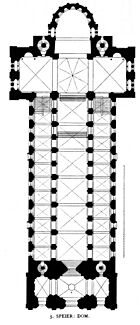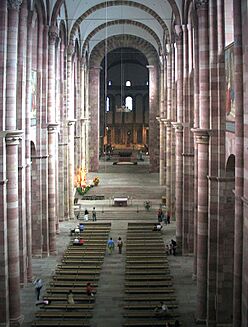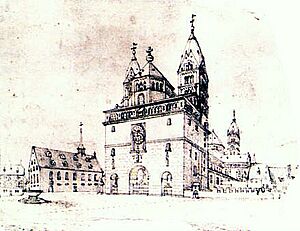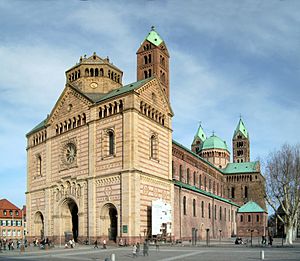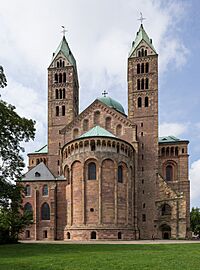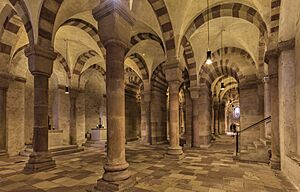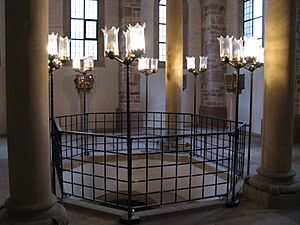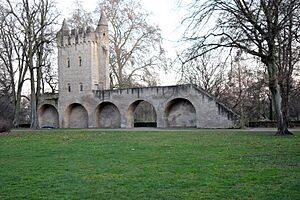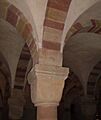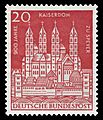Speyer Cathedral facts for kids
Quick facts for kids Speyer Cathedral |
|
|---|---|
| The Imperial Cathedral Basilica of the Assumption and St Stephen | |
|
Dom zu Unserer lieben Frau in Speyer
|
|
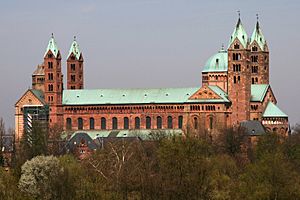 |
|
| 49°19′02″N 8°26′33″E / 49.3172°N 8.4424°E | |
| Location | Speyer |
| Country | Germany |
| Denomination | Roman Catholic |
| History | |
| Founded | 1030 |
| Founder(s) | Conrad II |
| Consecrated | 1061 |
| Architecture | |
| Functional status | Cathedral |
| Heritage designation | UNESCO World Heritage Site |
| Style | Romanesque |
| Administration | |
| Diocese | Diocese of Speyer |
Speyer Cathedral, also known as the Imperial Cathedral of Speyer, is a very old and important church in Speyer, Germany. Its full name is the Imperial Cathedral Basilica of the Assumption and St Stephen. It is the main church for the Roman Catholic Bishop of Speyer.
This huge church was started in 1030 by Emperor Conrad II. It is made of red sandstone and has three main sections inside. It is famous for its Romanesque architecture, a style of building popular in Europe from the 10th to 12th centuries. Speyer Cathedral was very important in shaping how other Romanesque buildings were designed.
Many emperors and kings from the Salian dynasty, Staufer, and Habsburg families were buried here. This shows how important the cathedral was as a symbol of their power. It is the largest Romanesque church still standing today. People consider it a "turning point in European architecture" and one of the best Romanesque buildings ever made.
In 1981, UNESCO added Speyer Cathedral to its World Heritage List. This means it is a very special cultural site that needs to be protected for everyone to see.
Contents
History and Design
Building in the Middle Ages
In 1025, Emperor Conrad II decided to build the biggest church in the Western world in Speyer. He also wanted it to be his final resting place. Building started in 1030 on a high area near the Rhine river, safe from floods. The red sandstone used for the church came from the nearby Palatine Forest mountains.
Neither Conrad II nor his son Henry III saw the cathedral finished. Conrad II died in 1039 and was buried there while it was still being built. Henry III was buried next to him in 1056. Their graves were placed in the middle section of the church, in front of the altar.
The cathedral was almost finished and officially opened in 1061. This first building phase, called Speyer I, had a main entrance area (Westwerk), a long central hall (nave) with two side aisles, and a cross-shaped section (transept). The main altar area (choir) had two towers next to it. The nave had a flat wooden ceiling, but the side aisles had arched ceilings. This made it the second largest building with arched ceilings north of the Alps. It was a great example of early Romanesque design.
Around 1090, Emperor Henry IV, Conrad's grandson, decided to make the cathedral even bigger. He had the eastern parts taken down and made the foundations stronger, digging up to eight meters deep. Only the lower parts and the crypt (an underground room) from Speyer I remained. The nave was made five meters taller, and the flat wooden ceiling was replaced with a stone arched ceiling. This was a huge achievement in Romanesque architecture. Each arch covered two sections of the church. Every second pillar was made wider to help support the heavy stone ceiling.
This new way of building, called the "double-bay system", helped support the stone arches. It was copied in many other churches along the Rhine river. The stone arches also allowed for large windows high up in the walls, letting in more light without making the building weak. The inside of the church became very grand and powerful.
During these changes, the cathedral also got a special outdoor walkway called a "dwarf gallery". This was an arched walkway built into the walls, just below the roof. It was a new and beautiful way to decorate the outside of the church. This feature became very popular in other Romanesque churches. Speyer Cathedral became a model for many other church buildings, but none were as grand.
The enlarged cathedral, Speyer II, was finished in 1106, the year Henry IV died. It was 134 meters long and 43 meters wide, making it one of the biggest buildings of its time. Building such a huge church in a small village like Speyer (which only had about 500 people) was a strong message from the emperor. He wanted to show his power, not just over the country but also over the church. This was part of a big disagreement between the emperor and the Pope. Henry IV was buried in the cathedral in 1111, after his excommunication (being kicked out of the church) was lifted.
For many centuries, the cathedral stayed mostly the same. Some small Gothic additions were made later, like a chapel and a window.
The last ruler was buried in the cathedral in 1308. In total, eight emperors and kings, along with some of their wives, were laid to rest here:
- Conrad II (died 1039) and his wife Gisela (died 1043)
- Henry III (died 1056), son of Conrad II.
- Henry IV (died 1106), son of Henry III, and his wife Bertha (died 1087)
- Henry V (died 1125), son of Henry IV.
- Beatrice I (died 1184), second wife of Frederick Barbarossa and their daughter Agnes
- King Philipp of Swabia (died 1208), son of Frederick Barbarossa
- King Rudolph of Habsburg (died 1291)
- King Adolph of Nassau (died 1298)
- King Albert I of Germany (died 1308), son of Rudolph of Habsburg
All these rulers were kings of Germany. To become a Holy Roman Emperor, they also needed to be crowned by the Pope. Sometimes, if the Pope and the German king did not get along, the Pope would refuse to crown the king as emperor. So, while they were all powerful rulers, some were "uncrowned" emperors. Many of Speyer's bishops and some of the rulers' wives are also buried here.
Changes in Modern Times
Even though Speyer and its cathedral were attacked and robbed many times, they survived the Thirty Years' War (1618–1648) without much damage. But during the Nine Years' War (1688–97), French soldiers attacked Speyer. People tried to save their belongings by piling them up inside the cathedral. However, on May 31, 1689, the soldiers broke in, robbed the imperial graves, and set the church on fire. Almost the entire town of Speyer burned down that day. The heat of the fire caused the western part of the church to collapse, and its later Gothic parts were destroyed.
After the big fire, the local bishops lost their home. They thought about building a new palace where the cathedral stood. But because the people of Speyer didn't like the bishop, he decided to build his palace somewhere else.
For almost 100 years, only the eastern part of the cathedral was safe enough to be used for church services. From 1748 to 1772, the building was repaired. The Romanesque nave was rebuilt, and the western entrance (westwork) was rebuilt in the Baroque style. However, there wasn't enough money to rebuild the whole cathedral in the Baroque style.
In 1792, French revolutionary soldiers again took over Speyer and robbed the cathedral. During the Napoleonic Wars (1803 to 1815), the cathedral was even used as a stable for horses and a storage place. In 1806, the French planned to tear down the building and use its stones for other projects. Luckily, the bishop of Mainz stopped them. After some big battles in 1813, many wounded soldiers came to Speyer, and the cathedral was used as a military hospital.
After the Congress of Vienna in 1815, Speyer became part of Bavaria. King Ludwig I of Bavaria ordered artists to decorate the inside walls of the cathedral with beautiful paintings (1846–1853). From 1854 to 1858, Ludwig's son, King Maximilian II, replaced the Baroque westwork with a new one in the Romanesque Revival style. This new westwork had two tall towers and an octagonal dome, making the cathedral look Romanesque again. The roofs were lowered and covered with copper.
On September 24, 1861, Prince Albert Edward, who later became King Edward VII of the United Kingdom, met his future wife, Princess Alexandra, at Speyer Cathedral for the first time.
The new westwork and interior decorations were considered amazing in the 19th century. King Ludwig I thought nothing greater had been created. However, by the early 1900s, opinions changed. Some art historians felt that the 19th-century changes were not good for the cathedral.
The graves of the emperors and kings were originally in the central aisle. Over time, people forgot their exact locations. In 1900, a big excavation found the graves, and the rulers were identified. Some items from the graves, like clothing, can be seen at the Historical Museum of the Palatinate. The restored coffins were moved to a new crypt (underground room) beneath the main altar in 1906, which is now open to visitors.
Starting in 1957, the cathedral underwent major restorations to make it strong and bring back its original look inside. Some of the plaster and 19th-century paintings were removed from the walls. Only 24 paintings showing scenes from the life of the Virgin Mary, located between the nave windows, were kept.
Gables (pointed roof sections) that had been removed from the transept and choir during the Baroque era were put back. Changes in the central crossing area were also reversed, but some Baroque reinforcements were kept for structural safety. The curved Baroque roof on the eastern dome also remained.
The Speyer Fragment of the Codex Argenteus
In October 1970, the last page of a very important book called the Codex Argenteus was found in the cathedral. This book contains a translation of parts of the New Testament into the Gothic language. The page was discovered during renovations of the Saint Afra chapel, hidden in a box. This page has text on both sides and contains the final verses of the Gospel of Mark.
Current Condition
Speyer Cathedral still looks much like it did in the 11th century. Even with many repairs and changes over time, it remains a complete and unified Romanesque building. Its design influenced many other churches in the Rhineland region of Germany. It has a high arched nave with side aisles, and a domed area where the main parts of the church cross, ending in a rounded altar section.
The western end has a detailed entrance structure called a "Westwerk," which is common in many Romanesque churches. The building's shape is balanced by two pairs of tall towers, one pair at the western end and one at the eastern end, with a dome at each end. Most of its outside features are still the same, but the inside has been changed a lot to make the building stronger.
The outside of the cathedral looks very consistent because all its openings are similar in size. Speyer has the earliest example in Germany of a "dwarf gallery" – a walkway with columns that goes all around the building just below the roof. This same type of gallery also decorates the eastern and western domes. The openings in the gallery match the size of the paired windows in the towers. The domes are both eight-sided, and the eastern one has a slightly oval roof. The towers have special "Rhenish helm" spires (pointed roofs). The nave, towers, and domes are all covered with copper, which has turned a pale green color over time. This green contrasts with the pinkish-red stone of the building and the colorful stone of the Westwerk.
Inside, the nave has two open levels with simple, rounded Romanesque arches. The main arches are supported by simple pillars, each with a wide attached column. Every other column supports a stone arch of the high ceiling. The square sections formed by these arches have arched ceilings and are plastered. Most of the 19th-century plasterwork has been removed from the walls, but a series of colorful paintings showing the Life of the Virgin remains between the windows of the nave.
The cathedral recently had major restorations that cost about 26 million Euros. Also, the frescos (wall paintings) by Johann Schraudolph, which were removed in the 1950s, were restored. They are now displayed in the "Kaisersaal" (Emperor's Hall) of the cathedral.
- Stages of construction and reconstruction
World Heritage Site Status
In April 1981, Speyer Cathedral was added to the UNESCO World Heritage List. This means it is recognized as a very important cultural site. The International Council on Monuments and Sites (ICOMOS) explained why: "The cathedral of Speyer, along with the cathedrals of Worms and Mayence (Mainz), is a major example of Romanesque art in the German Empire. It is the largest and most important because of its size and its history – the Salian emperors chose it as their burial place." ICOMOS also noted that the building is important because it shows how ideas about restoring old buildings have changed since the 17th century, both in Germany and around the world.
Cathedral Size
- Total length: 134 meters (from the entrance steps to the outside wall of the eastern altar area)
- Outside width of the nave (with side aisles): 37.62 meters (from outside wall to outside wall)
- Inside width of the nave: 14 meters
- Height of the nave at the highest point of the arches: 33 meters
- Height of the eastern spires (pointed roofs): 71.20 meters
- Height of the western spires: 65.60 meters
- Crypt Length: east-west 35 meters; north-south 46 meters. Height: between 6.2 meters and 6.5 meters.
Special Features
The Crypt
Over many centuries, crypts (underground rooms in churches) grew from small spaces into large, impressive halls. These "hall crypts" became common in Italy and Germany, sometimes even extending under the cross-shaped parts of the church.
The huge crypt of Speyer Cathedral was officially opened in 1041. It is the largest Romanesque crypt with columns in Europe. It covers an area of 850 m2 (9,149 sq ft) and is about 7 meters high. Forty-two arched ceilings are supported by twenty round columns with simple tops. The sandstone blocks used in the crypt are yellow and rust-colored, a common design from the Salian and Staufer periods. This color scheme also inspired the look of the 19th-century front of the church. The crypt is known for its clear and precise design.
Chapels
On the south side of the cathedral is a double chapel for Saint Emmeram (also known as Saint Martin) and Saint Catherine. Double chapels, which have two levels connected by an opening, were common in imperial and bishop's chapels by the late 11th century. Building this one in Speyer started around 1050. Saint Catherine's chapel was built to celebrate the birthday of Henry III's daughter on November 25, named after Saint Catherine of Alexandria. In 1961, the chapel was restored to its original double-chapel design. Today, Saint Emmeram's chapel is used for baptisms.
On the north side of the cathedral is the chapel of Saint Afra, named after an early Christian martyr. Emperor Henry IV had this chapel built because he was born on her special day. Saint Afra's remains were found in Augsburg around 1064. Henry IV was buried in this chapel from 1106 to 1111, until his excommunication was lifted. During restoration work in 1971, a page of parchment was found in the chapel. It was part of a Wulfila Bible written around 500 AD. Today, the Saint Afra Chapel is used as a tabernacle (a place to keep sacred items).
Originally, there were five other chapels on the northern side of the cathedral: Saint Paul, Saint Agnes, Saint Bernard, Saint Henry, and Saint Mary. Saint Mary's chapel was added in 1475. The ruins of these chapels were removed in the 18th century.
Bells
The cathedral has nine bells. The four largest bells were made in 1822, and the five smaller ones were made in 1963. All the bells are in the western dome of the cathedral. In Germany, bells are numbered from largest to smallest. The four largest bells also act as clock bells: bells 4 and 3 chime every 15 minutes, while bells 2 and 1 strike the full hour.
| No. | Name | Nominal | Weight (kg) |
Diameter (cm) |
|---|---|---|---|---|
| 1 | Maximilianus Josephus (Emperor Bell) | G0 | 5350 | 208 |
| 2 | Friderica Wilhelmina Carolina | B♭0 | 2600 | 175 |
| 3 | Ludovicus Carolus | D♭1 | 1650 | 147 |
| 4 | Matthaeus de Chandelle | F1 | 600 | 115 |
| 5 | Saint Mary's Bell | A♭1 | 601 | 95.5 |
| 6 | Saint Joseph's Bell | B♭1 | 494 | 90.3 |
| 7 | Saint Anne's Bell | D♭2 | 440 | 83.3 |
| 8 | Saint Pirmin's Bell | E♭2 | 312 | 75 |
| 9 | Otto | F2 | 217 | 66.7 |
Around the Cathedral
In the past, many buildings surrounded the cathedral. To the south, there was a cloister (a covered walkway) with a sculpture of the Mount of Olives in the middle. On the north side was the bishop's large residence. Other buildings included a chapter house, rectory, archives, and town defenses. Most of these buildings disappeared after the French Revolution. You can still see the outline of the old cloister in the pavement today.
The sculpture of the Mount of Olives was damaged in the great fire of 1689. Its ruins were left after the cloister was cleared in 1820 to create an open space. Later, a roof was added to protect it. Inside the Mount of Olives sculpture is a chapel dedicated to the Archangel Michael.
In the square at the western end of the cathedral is a large stone bowl called Domnapf (meaning 'cathedral bowl'). This bowl used to mark the border between the bishop's land and the town's land. Whenever a new bishop was chosen, he had to fill the bowl with wine, and the townspeople would drink it to celebrate him.
Heidentürmchen (Heath Tower)
The Heidentürmchen is a remaining part of the medieval town walls. It is a tower and a section of the wall located a little east of the cathedral. It used to stand right by the Rhine river, at the edge of a marshy area once called "heath."
Hall of Antiques (Antikenhalle)
This hall was built north of the cathedral to display Roman artifacts found in the cathedral area. It was built in a classical style but turned out to be too small. Later, some cannons captured in the Franco-Prussian War of 1870/71 were displayed there. Today, it serves as a memorial for those who died in the two world wars.
- Features of Speyer Cathedral and its surroundings
German Postage Stamps featuring Speyer Cathedral
See also
- Roman Catholic Marian churches
- List of regional characteristics of Romanesque churches
- List of tallest domes
- Bamberg Cathedral
- Worms Cathedral
- Mainz Cathedral
- History of medieval Arabic and Western European domes
- List of cathedrals in Germany


